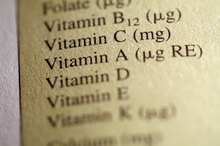Vitamin B-6 & Tendonitis
Tendinitis is a condition marked by inflammation of your tendons and ligaments, which are tissues that connect your muscles together and connect muscles to bones. It may cause symptoms such as pain, stiffness, joint swelling and sensitivity to touch. Tendinitis is typically caused by repetitive movements, overuse of joints or injuries. Although vitamin B-6 cannot cure tendinitis, it may help reduce the symptoms of this condition. Talk to your physician before taking vitamin B-6 to address tendinitis.
Protein and Fat Metabolism
Proteins are amino acids that serve as building blocks of muscles and connective tissue, and fats aid in maintaining elasticity 1. The role of vitamin B-6 in the metabolism of these nutrients may help your body repair tendons and ligaments and may help prevent future injuries.
Immune System Function
Vitamins for Tendinitis
Learn More
Your body's immune system is responsible for locating and destroying virus cells, fungi and bacteria in your body that can cause infection. Infection can damage the cells of your tendons and ligaments and may increase inflammation, stiffness and pain. Vitamin B-6 may help improve immune system function by stimulating the production of white blood cells that destroy infection-causing bacteria, fungi and virus cells, according to Balch.
Sources
Vitamin B-6 is typically included in multivitamin and B-complex supplements. It is also available as a stand-alone supplement. This vitamin is also found in foods such as:
- chicken
- eggs
- wheat germ
- carrots
- cantaloupe
- bananas
- corn
- cabbage
Certain herbs, such as catnip and alfalfa, also contain vitamin B-6, according to Balch. However, talk to your physician before using herbs to obtain vitamin B-6 or treat tendinitis -- any herb may cause side effects or allergic reactions.
- Vitamin B-6 is typically included in multivitamin and B-complex supplements.
Considerations
Vitamins for Glandular Fever
Learn More
There is no specific daily recommended vitamin B-6 intake for tendinitis apart from general intake recommendations. The general recommended daily intake is 1.3 mg for adults, according to the University of Maryland Medical Center 2. Doses moderately above the daily recommended intake are considered safe; however, consuming more than 200 mg of vitamin B-6 per day may cause neurological problems such as poor balance and loss of feeling in your legs. Vitamin B-6 may also interfere with the absorption of tetracycline antibiotics.
- There is no specific daily recommended vitamin B-6 intake for tendinitis apart from general intake recommendations.
- Doses moderately above the daily recommended intake are considered safe; however, consuming more than 200 mg of vitamin B-6 per day may cause neurological problems such as poor balance and loss of feeling in your legs.
Related Articles
References
- "Prescription for Nutritional Healing"; Phyllis A. Balch, C.N.C., et al.; 2010
- University of Maryland Medical Center: Vitamin B-6 (Pyridoxine)
- Davey, M. W., Montagu, M. V., Inzé, D., Sanmartin, M., Kanellis, A., Smirnoff, N., ... & Fletcher, J. (2000). Plant Lâascorbic acid: chemistry, function, metabolism, bioavailability and effects of processing. Journal of the Science of Food and Agriculture, 80(7), 825-860.
- Alessio, H. M., Hagerman, A. E., Fulkerson, B. K., Ambrose, J. E. S. S. I. C. A., Rice, R. E., & Wiley, R. L. (2000). Generation of reactive oxygen species after exhaustive aerobic and isometric exercise. Medicine and Science in Sports and Exercise, 32(9), 1576-1581.
- Padayatty, S. J., Katz, A., Wang, Y., Eck, P., Kwon, O., Lee, J. H., ... & Levine, M. (2003). Vitamin C as an antioxidant: evaluation of its role in disease prevention. Journal of the American College of Nutrition, 22(1), 18-35.
- Bendich, A., & Langseth, L. (1995). The health effects of vitamin C supplementation: a review. Journal of the American College of Nutrition, 14(2), 124-136.
- Douglas, R. M., & Hemilä, H. (2005). Vitamin C for preventing and treating the common cold. PLoS Medicine, 2(6), e168.
- Bryer, S. C., & Goldfarb, A. H. (2006). Effect of high dose vitamin C supplementation on muscle soreness, damage, function, and oxidative stress to eccentric exercise. International Journal of Sport Nutrition and Exercise Metabolism, 16(3), 270-280.
- Nakhostin-Roohi, B., Babaei, P., Rahmani-Nia, F., & Bohlooli, S. (2008). Effect of vitamin C supplementation on lipid peroxidation, muscle damage and inflammation after 30-min exercise at 75% VO^ sub 2max^. Journal of Sports Medicine and Physical Fitness, 48(2), 217.
- Li, H., Zou, Y., & Ding, G. (2012). Dietary factors associated with dental erosion: a meta-analysis. PloS One, 7(8), e42626.
- Moertel, C. G., Fleming, T. R., Creagan, E. T., Rubin, J., O'Connell, M. J., & Ames, M. M. (1985). High-dose vitamin C versus placebo in the treatment of patients with advanced cancer who have had no prior chemotherapy: a randomized double-blind comparison. New England Journal of Medicine, 312(3), 137-141.
- Bruno, R. S., Leonard, S. W., Atkinson, J., Montine, T. J., Ramakrishnan, R., Bray, T. M., & Traber, M. G. (2006). Faster plasma vitamin E disappearance in smokers is normalized by vitamin C supplementation. Free Radical Biology and Medicine, 40(4), 689-697. .
- Huang, J., & May, J. M. (2003). Ascorbic acid spares α-tocopherol and prevents lipid peroxidation in cultured H4IIE liver cells. Molecular and Cellular Biochemistry, 247(1), 171-176.
- Kalgaonkar, S., & Lönnerdal, B. (2008). Effects of dietary factors on iron uptake from ferritin by Caco-2 cells. The Journal of Nutritional Biochemistry, 19(1), 33-39.
- Monsen, E. R. (2000). Dietary reference intakes for the antioxidant nutrients: vitamin C, vitamin E, selenium, and carotenoids. Journal of the American Dietetic Association, 100(6), 637-640.
Writer Bio
Owen Pearson is a freelance writer who began writing professionally in 2001, focusing on nutritional and health topics. After selling abstract art online for five years, Pearson published a nonfiction book detailing the process of building a successful online art business. Pearson obtained a bachelor's degree in art from the University of Rio Grande in 1997.









